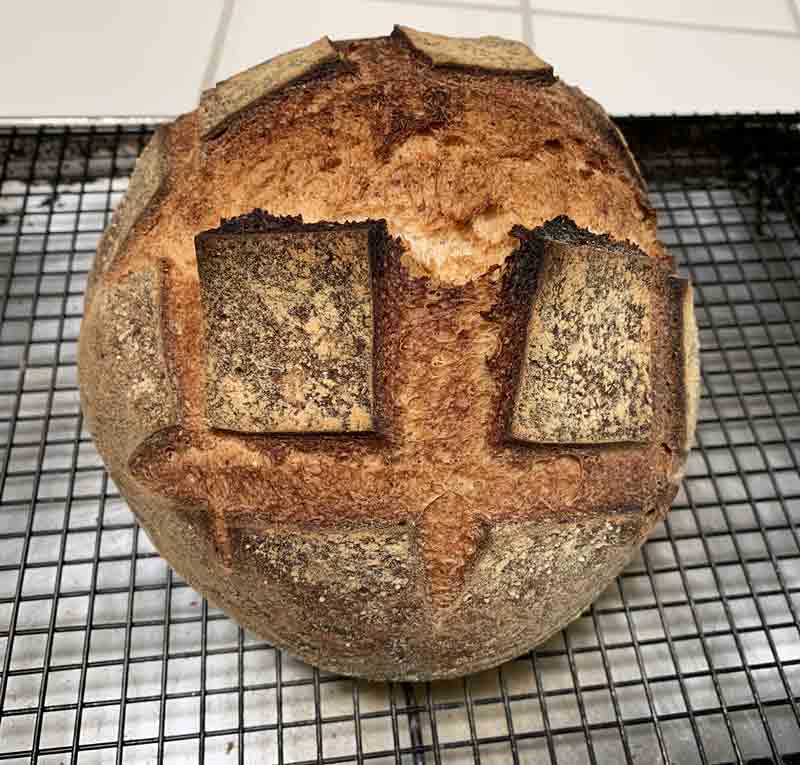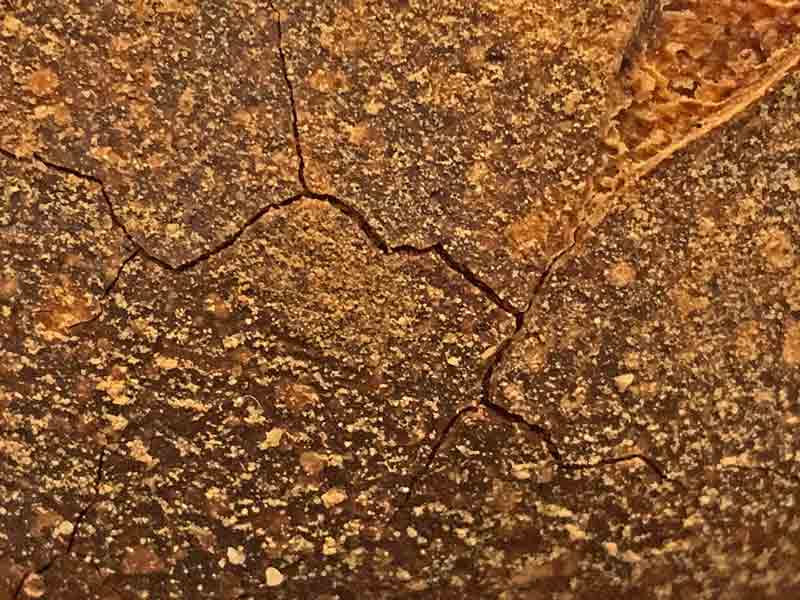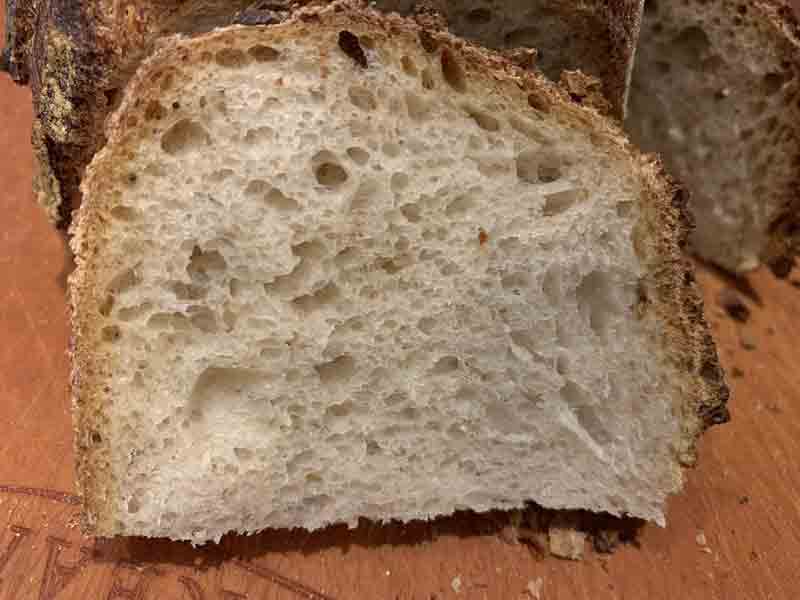
Sourdough Bread
Based on the method of Ramon Padilla
March, 2019
David Snyder
Ramon Padilla is a retired baker. From 18 years old until he retired, he baked for the Parisian Bakery and the Boudin Bakery in San Francisco. He was the baker responsible for the fabulous sourdough bread served at The Tadich Grill. He told me he baked it at Parisian until they closed and then at Boudin. Today, his brother is head baker at Boudin and still makes the bread for The Tadich Grill. In retirement, Ramon has continued to bake bread at home.
Ramon very generously shared the way he bakes bread currently. Interestingly enough, it has some similarities and some differences compared to the published account of the Larraburu method. The most striking similarity is the very short bulk fermentation and very long proofing. The biggest difference is that Ramon's entire process is at room temperature. He did tell me that getting the dough temperature right is an important consideration. He neglected to tell me his DDT (desired dough temperature).
I have modified Ramon's formula and procedures in a few ways, to suite my taste and schedule. His formula calls for all white flour – high gluten for the starter and all purpose for the final dough. I substituted in a bit of whole wheat and whole rye. Ramon does a long (over 8 hour) final proof at room temperature. In order to fit my schedule and in order to increase the acetic acid production, I proofed at room temperature for a shorter time, then cold retarded the formed loaves and proofed further at a warm temperature before baking.
This is an experiment for me. It is not unlikely I will make modifications after seeing how this bake turns out.
Total Dough |
|
|
Ingredient | Wt (g) | Bakers' % |
Total flour | 1000 | 100 |
AP | 799 | 80 |
High-gluten flour | 101 | 10 |
WW | 50 | 5 |
Rye | 50 | 5 |
Water | 600 | 60 |
Salt | 20 | 2 |
Total | 1620 | 162 |
Note: The original recipe and the San Francisco Sourdough of yore are 100% low extraction (white) flour. I have modified this by including 10% whole grain flour, because that is my preference. Besides effects on flavor complexity and nutrition, the anticipated effects would be: 1) A less open crumb, 2) faster fermentation, 3) enhanced acid production.
Note: 15.7% of the flour is pre-fermented. This is less than most sourdough formulas which average 20-25% pre-fermented flour. The effect would be: 1) A longer fermentation/proofing, 2) more acid content at the time of dividing and shaping.
Starter |
|
|
Ingredient | Wt (g) | Bakers' % |
High-gluten flour | 101 | 75 |
WW flour | 34 | 25 |
Water | 81 | 60 |
Active firm starter | 34 | 25 |
Total | 250 | 185 |
Note: The 34g of active firm starter consists of 13g water + 16g AP flour + 5g WW flour.
The night before mixing the Final Dough, dissolve the active firm starter in the water.
Add the flours and mix thoroughly.
Cover and ferment at room temperature overnight.
Final Dough |
|
Ingredient | Wt (g) |
AP flour | 783 |
WW flour | 11 |
Rye flour | 50 |
Water (warm) | 506 |
Salt | 20 |
Starter | 250 |
Total | 1620 |
Procedures
Place all the ingredients in the bowl of a stand mixer. Mix at Speed 1 for 2 minutes to distribute ingredients then for about 9 minutes at Speed 2 to develop the dough. Final dough temperature was 76ºF.
Transfer the dough to a lightly floured board.
Do one stretch and fold. Cover the dough and let it rest for 30 minutes.
Do one more stretch and fold and transfer the dough to a clean, lightly oiled bowl.
Cover the bowl and ferment at room temperature for 1hour.
Divide the dough into two equal pieces, pre-shape into rounds and cover. Let rest for 10-30 minutes.
Shape as boules or bâtards and place in floured bannetons or on a couch, seam-side up.
Cover and let proof at room temperature until 75% proofed (6.5 hours for me at 68ºF).
Refrigerate (cold retard) for 12-32 hours. (The longer, the more sour the bread will be.)*
If you think the loaves need it, proof at room temperature for additional time before baking.
Transfer to a peel. Score as desired.
Bake: If baking in Dutch oven, bake at 475ºF covered for 20 minutes, then uncovered at 450ºF for another 10 minutes or until done to satisfaction.
Bake: If baking on the hearth, pre-heat oven at 500ºF for 1 hour with baking stone and steaming apparatus in place. Turn down oven to 460. Load loaf and steam oven. After 15 minutes, remove steam and continue baking for 20-35 minutes, until loaf is baked. (Depends on size and shape of loaf.)
The bread is done when the crust is nicely colored and the loaf sounds hollow when thumped on the bottom. The internal temperature should be at least 205ºF.
Transfer the bread to a cooling rack and cool thoroughly before slicing.
* To test the expectation that a longer cold retardation would produce a more sour loaf, I made two loaves. One was baked after 18 hours in the fridge a 2 hours more at room temperature. The other was baked after 22 hours in the fridge and 3 hours more at room temperature. Both were baked on a baking stone, as described in Step 13.
The first photo is of the loaf that was retarded for a longer time. The photo below is of the bread retarded the shorter time.

The following photos of crust and crumb are from this second loaf (the one retarded for a shorter time).


The first of these loaves - the one cold retarded for 18 hours - was sliced and tasted when completely cooled. The crust was very crunchy with a nutty flavor. The crumb was cool and chewy. It had a somewhat sweet flavor with a lactic acid-type acidity predominating. It had a hint of acetic acid tang only. Among the variations of San Francisco Sourdough, this bread was considerably closer to Acme's than to the Parisian/Tadich Grill style. Excellent bread.
The morning after these loaves were baked, I tasted each. The first loaf's flavor had not changed overnight. The second loaf which had been cold retarded a few hours longer had pretty much the same flavor profile but with just a bit more of an acetic acid tang. Wheaty and lactic acid flavors predominated.
These are very good breads. I especially like the very crunchy crust. I think that is the result of the low hydration. I haven't decided where to go next with this series of experiments. I wonder if keeping a firm starter going for a few weeks would encourage heterofermentative lactobacilli to grow and result in more acetic acid flavor.
Happy baking!
David
- dmsnyder's Blog
- Log in or register to post comments
Most amazing crust color on your lead photo, crumb looks lovely.
Bravo, and keep on baking,
Carole
Now I don’t know what bread to bake! This one looks delicious and has jumped to the top of the list. Just going to get my starter at 60% hydration. IT’s currently at 100%.
Thanks David. You do amazing research and history of the breads and it’s fascinating!
and inspiring how you approached those loaves. I am also very excited to see that your firm starter seems to be 50% hydration unless I've got my Maths wrong...and then used to build a 60% hydration leaven.... I am training a new 50% starter offspring from my liquid starter at the moment to get a routine being fed in the morning and the evening and trying to learn how best to judge when it is ripe to being refreshed or used? It might live in the fridge then but for now like to observe and learn. For now I am looking at bubbles on the side and dimples in domed top..to judge readiness. Sorry as I am going off piste from your lovely thread and looking forward to seeing the other loaf. Kat
Nice looking bread. I make a similar one but cold retard it a bit longer. I am curious . . . When you write High-gluten flour, do you mean bread flour, e.g. King Arthur Bread Flour or something similar or do you refer to a specific clear or other high gluten type? Thanks.
I used "High-protein Bread Flour" from Breadtopia dot com. It has 13.5% protein, so higher than KAF Bread Flour but lower than KAF Sir Lancelot, which is their high-protein flour.
David